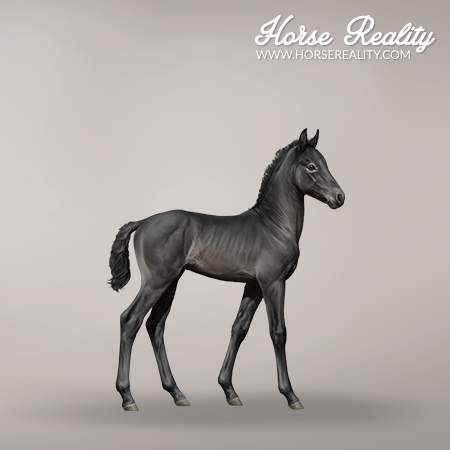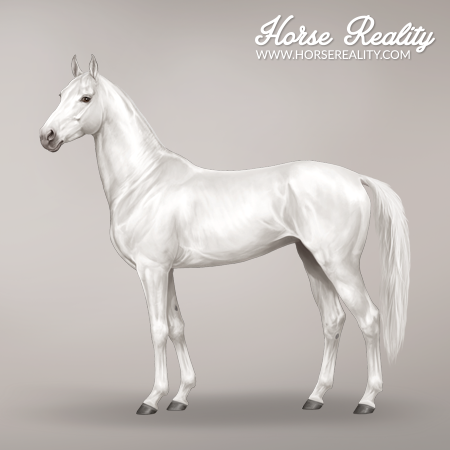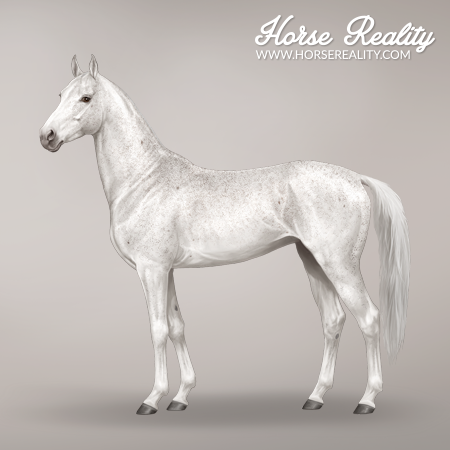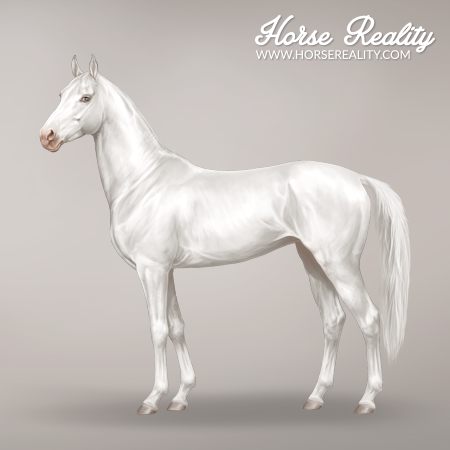Grey is one of the different modifiers that can affect the colour of horses.
¶ Phenotype
Grey can be characterised as a progressive loss of pigment over the horse's lifetime. Horses will be born with the coat determined by their genes, but will gradually turn grey with each shed and eventually become nearly “white" in colour. This process is called greying. Grey doesn't cause any depigmentation of the skin or eyes, so grey horses will have dark skin and dark eyes (unless other white markings, white patterns and/or dilutions are affecting the skin and/or eyes).
Even though foals are born with their “normal” colour, it is often possible to tell whether they're going to turn grey later. Grey foals often show hyperpigmentation: their coat will appear darker and more saturated. Black foals, for example, usually have a more greyish colour when they are born; while grey black foals will actually look pure black. Foals will also often show “grey goggles”: white/grey hairs around the eyes that make the foal look like it wears glasses. Grey foals usually lack typical foal camouflage. Some foals may show these signs of grey more strongly than others.
| Grey foal - Akhal-Teke Horse |

|
While going through the greying process, horses will usually pass through different “stages” of grey (dapple grey, steel grey,…). The first grey hairs usually appear on the head. The legs are usually the last part to turn white, especially in horses with a dark base coat. Some horses eventually become completely white, others retain a small amount of pigment for many years. In some older white horses, partial repigmentation may occur: they actually regain some coloured hairs (fleabitten grey). Sometimes, they will develop a non-grey marking on their body, called a bloody shoulder. Despite the name, it may appear anywhere on the body.
In Horse Reality, horses don't move between all the different grey stages. Rather, they randomly get assigned a specific stage of grey once they turn into an adult (3 years old) and retain this shade for the rest of their life. The shades of grey that are possible for horses to turn into, may depend on their original coat colour.
The speed of the greying process can differ a lot between horses and breeds, and this difference appears to be at least somewhat hereditary. Some breeds, such as Camargue Horses or Lipizzaner Horses, tend to grey out and turn white very fast. In rare cases, horses of certain lineages may not show any signs of greying until very late in life.
As the grey progresses, it will become harder and harder to recognise the horse's original coat colour. If a horse has any white markings or patterns, the white patches may also become hard to see. The skin in these areas will still be pink, though, and this becomes especially visible when a grey horse is soaked with water.
In real life, grey horses are prone to developing melanomas (skin tumours, usually benign). This is however not a feature in Horse Reality.
| Grey Stages - Akhal-Teke Horse and Arabian Horse | |
| Example | Information |

|
Dark dapple grey An early/intermediate grey stage where light and dark areas form a “dappled” pattern over the entire coat: dark rings with a lighter colour on the inside. |

|
Steel grey An intermediate grey stage where the white hairs are mixed in evenly with a dark original colour, giving the horse a silvery look. |

|
Rose grey An intermediate grey stage where the white hairs are mixed in evenly with the red (chestnut/bay) coat colour, giving the horse a light reddish tint. |

|
Light dapple grey A late stage where the dapples on the coat have almost completely greyed out. The pigment is mostly retained on the legs. |

|
“White” grey A late/final stage of grey. Nearly all hairs are fully depigmented and white. |

|
Fleabitten grey A fully “white” coat with small, pigmented speckles. The number of speckles can vary between horses. They usually go through a fully “white” stage first and sometimes gain more speckles as they age. |

|
Bloody Shoulder A bloody shoulder is a heavily pigmented area on the coat of a grey horse. It can be seen as many fleabitten specks that have merged into a big spot. |

|
Homozygous cream grey Grey horses can typically be recognised by their dark skin and eyes underneath their "white" coat; but the presence of dilutions or white patterns, such as homozygous cream, may cause pink skin. |
¶ Genotype
Grey is caused by the dominant G-allele of the grey (STX17) gene. The G-allele causes the pigment-producing cells (melanocytes) to produce pigment very intensely for a period of time; this is the reason for the hyperpigmentation of grey foals. Eventually, the melanocytes will essentially “burn out” and stop producing pigment.
Below, the resulting phenotype of each genotype is listed:
- G/G = Grey
- G/g = Grey
- g/g = Not grey
Grey can be tested at the Laboratory.
In real life, research indicates that horses with two copies of the grey allele (homozygous, G/G) tend to grey out faster and are more likely to develop melanoma than horses with one copy (heterozygous, G/g).
¶ Breeds
Grey is present in many horse breeds all over the world, from ponies to draft breeds. The following table lists all breeds that can currently have the grey (G) allele in-game:
| Breeds |
| Akhal-Teke Horse |
| Arabian Horse |
| Brabant Horse |
| Brumby Horse |
| Camargue Horse |
| Cleveland Bay |
| Exmoor Horse |
| Finnhorse |
| Fjord Horse |
| Friesian Horse |
| Haflinger Horse |
| Icelandic Horse |
| Irish Cob Horse |
| Kladruber Horse |
| Knabstrupper |
| Lipizzaner Horse |
| Lusitano |
| Mongolian Horse |
| Mustang Horse |
| Namib Desert Horse |
| Noriker Horse |
| Norman Cob |
| Oldenburg Horse |
| Pantaneiro Horse |
| Pura Raza Española |
| Quarter Horse |
| Shetland Pony |
| Shire Horse |
| Suffolk Punch |
| Thoroughbred |
| Trakehner Horse |
| Welsh Pony |
¶ References
- Bellone R., Sponenberg D. P., Equine Color Genetics, 4th Edition, 2017, Wiley-Blackwell
- UC Davis Veterinary Genetics Laboratory; https://vgl.ucdavis.edu/test/gray; Access: November 2022
- Generatio Center for Animal Genetics; https://generatio.de/en/guidance/lexicon/grey-progressive-whitening-horse; Access: November 2022